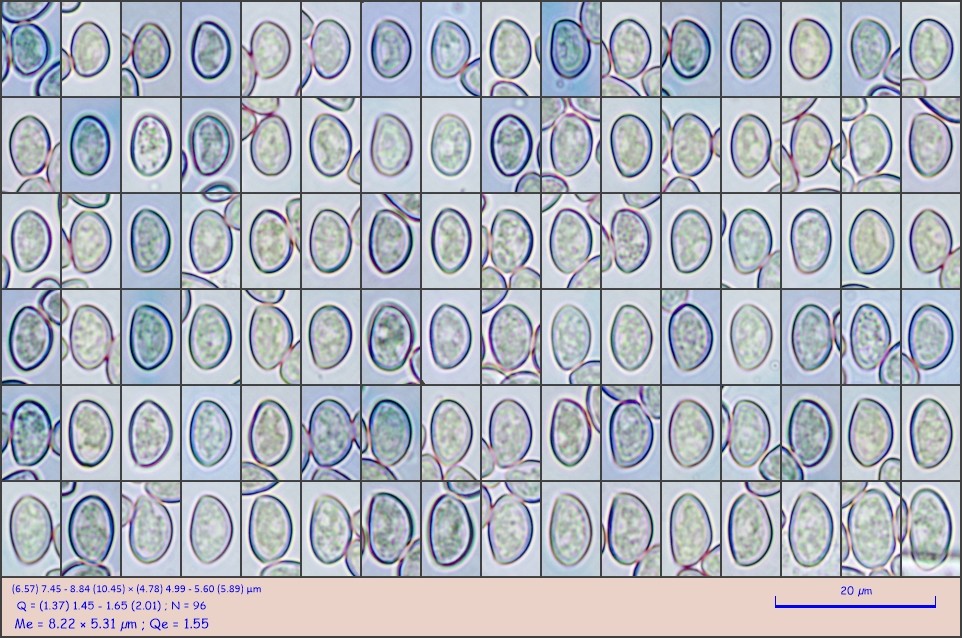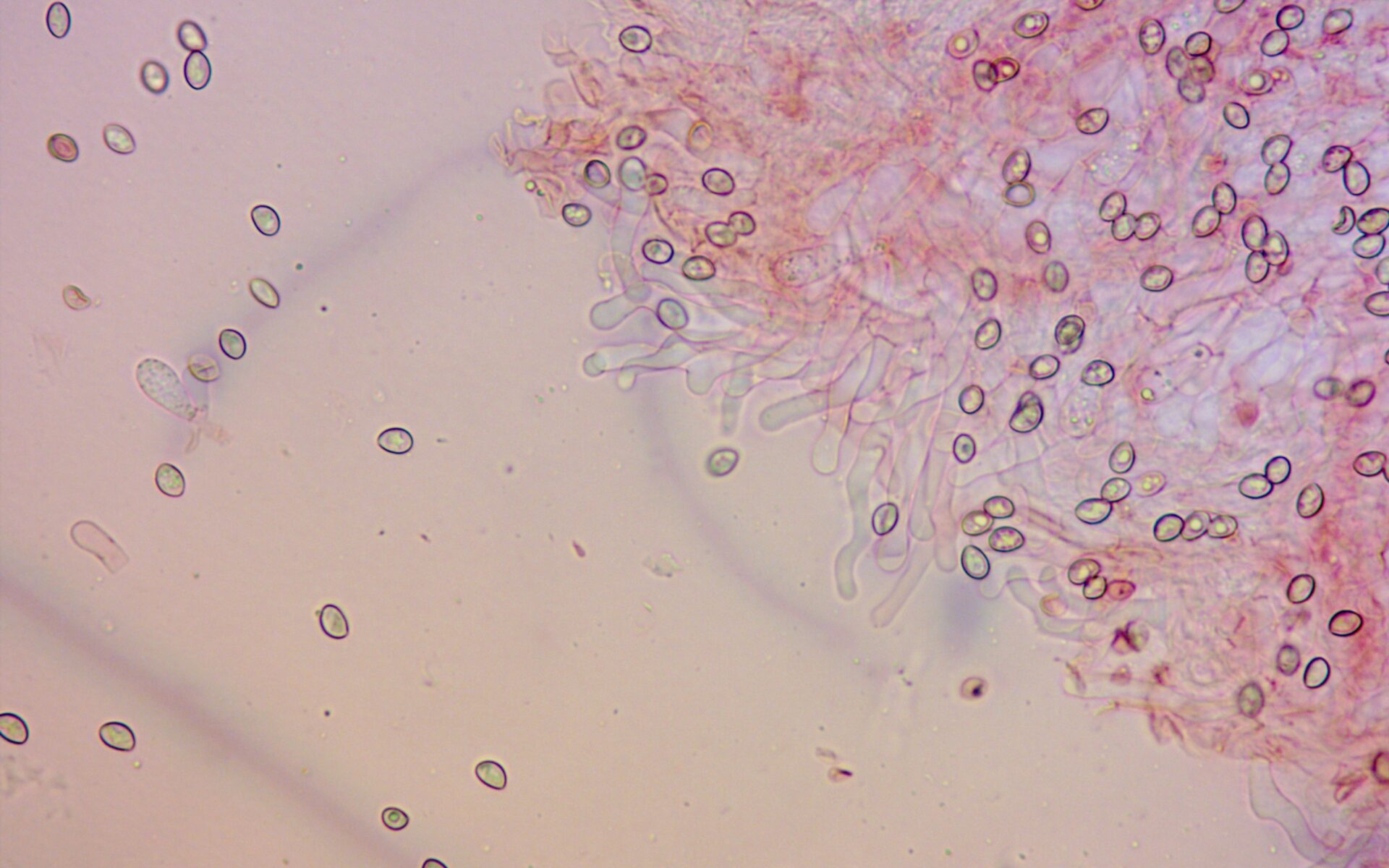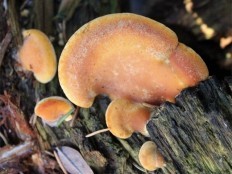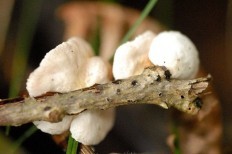Tse ka Hare
Soft crepidot (Crepidotus mollis)
- Karolo: Basidiomycota (Basidiomycetes)
- Karohano: Agaricomycotina (Agaricomycetes)
- Sehlopha: Agaricomycetes (Agaricomycetes)
- Sehlopha-potlana: Agaricomycetidae (Agaricomycetes)
- Taelo: Agaricales (Agaric kapa Lamellar)
- Lelapa: Inocybaceae (Fibrous)
- Rod: Crepidotus (Крепидот)
- Type: Crepidotus mollis (crepidot e bonolo)
- Agaric ea lebese Scopoli (1772)
- Lerako la Agaric Scopoli (1772)
- Agaric e bonolo Schaeffer (1774)
- Agaricus cannescens Batsch (1783)
- Gelatinous agaric JF Gmelin (1792)
- Agaricus violaceofulvus Vahl (1792)
- Dendrosarcus alni Paulet (1808)
- Crepidopus e bonolo (Schaeffer) Gray (1821)

Lebitso la sebele Crepidotus mollis (Schaeffer) Staude (1857)
Etymology of generic and specific epithets from Crepidotus m, Crepidot. Ho tloha ho crepis, crepidis f, sandal + ούς, ωτός (ous, ōtos) n, tsebe.
mollis (lat.) - e bonolo, e bonolo, e tenyetseha.
Litholoana tsa 'mele cap sessile, semicircular, kidney-shaped in young mushrooms in a circle, then shell-shaped fan-shaped, from pronouncedly convex to convex-prostrate, prostrate, attached sideways to the woody substrate. At the point of attachment, there is often a long-lasting rounded bulge. The edge of the cap is slightly tucked up, sometimes uneven, wavy, with age and with high humidity it can be slightly translucent. The surface is gelatinous, smooth, matte, sometimes covered with darker small sparse hairs or scales. The color of the surface is quite variable – from light yellow fawn to yellow-orange and even brown shades. No wonder the second popular name for the mushroom is chestnut crepidot. The gelatinous cuticle is elastic and separates quite easily.
Boholo ba cap e tloha ho 0,5 ho isa ho 5 cm, tlas'a maemo a matle a kholo e ka fihla ho 7 cm.
Makhasi ao rekere e nama. Mmala - shades ho tloha mosehla o mosehla ho ea beige, tranelate, 'mala ha o fetohe nakong ea khefu.
Ha ho monko kapa tatso e ikhethang. Mehloli e meng e bontša boteng ba tatso e monate e monate.
Hymenophore lamellar. Lipoleiti li na le sebopeho sa fan, li sekametse ka mahlaseli 'me li khomarela sebakeng sa ho khomarela substrate, hangata, li tšesaane, li na le fereko e nang le bohale bo boreleli. Ho na le lipoleiti tse khutšoane tse sa fihleng kutu ea boikaketsi. 'Mala oa lipoleiti tsa li-mushroom tse nyane o tšoeu, beige e bobebe, ka lilemo, ha li-spores li ntse li hola, li fumana tint e sootho. Mehlala ea khale haholo, hymenophore e kanna ea ba le matheba a bofubelu bo sootho botlaaseng.
leoto ka li-mushroom tse nyenyane, rudimentary e nyenyane haholo, 'mala o tšoanang le lipoleiti, kapa ha e eo ka ho feletseng.
Maekorosekopo
Spore phofo ke ocher, sootho.
Li-spores (6,2) 7-8,5 × 4-5,3 µm, ellipsoid, asymmetric hanyenyane, marako a tšesaane, a boreleli ka lerako le batlang le le teteaneng, mosehla o khanyang, o batlang o se na 'mala, o sootho oa koae ka bongata.

Basidia 18–30 × 6–9 µm, e bōpehileng joaloka club, e nang le granular content ho fihlela ho 30 µm ka boholo, boholo ba 4-spored, empa ho boetse ho na le tse peli-spored, ntle le clasp botlaaseng.
Cheilocystidia 25 - 65 × 5 - 10 µm. cylindrical, sebopeho sa botlolo kapa sebopeho sa mokotla.

Pileipellis e entsoe ke lera le tšesaane la lisele tsa cylindrical, ka linako tse ling li kobehile hanyenyane.
Soft crepidote ke saprotroph holim'a likutu le patsi e shoeleng ea lifate tse makhasi. Hangata e hola ka lihlopha tse kholo holim'a lehong la mefuta e mengata, ho kenyelletsa le linden, aspen, maple, poplar, alder, beech, oak, sefate sa sefofane, hangata ho li-conifers (phaene), e khothalletsa ho thehoa ha bola bo bosoeu. Ka linako tse ling e lula lifate tse phelang. E fumaneha hohle ho tloha ka May ho ea ho October. Nako e phahameng ea litholoana - June-September. Sebaka sa kabo ke sebaka se futhumetseng sa leholimo sa Europe, Amerika Leboea, Naha ea Rona. Litaba tse rekotiloeng Afrika, Amerika Boroa.
Li-mushroom tsa boleng bo tlase tse jeoang. Mehloli e meng e bonts'a lisebelisoa tse ling tsa bongaka, empa tlhahisoleseling ena ke likaroloana ebile ha e tšepahale.

Crepidot e entsoeng ka bokhabane (Crepidotus calolepis)
- ka kakaretso, e tšoana haholo, e fapane le boteng ba sekala holim'a cap, microscopically - ka li-spores tse kholoanyane.

Li-mushroom tsa oyster ea Orange (Phyllotopsis nidulans)
- e khetholloa ke 'mala o khanyang oa lamunu oa cap le ho ba sieo ha gelatin-like cuticle, hammoho le monko o hlakileng, ho fapana le crepidot e bonolo, e batlang e se na monko.

Phapang ea Crepidot (Crepidotus variabilis)
- e nyane ka boholo, lipoleiti li bonahala li fokola khafetsa, bokaholimo ba cap ha bo na gelatinous, empa bo ikutloa bo le pubescent.
- Agaricus babalinus Persoon (1828)
- Agaricus alveolus Lasch (1829)
- Pleuropus mollis (Schaeffer) Zawadzki (1835)
- Agaricus cheimonophilus Berkeley le Broome (1854)
- Crepidotus mollis (Schaeffer) Staude (1857)
- Crepidotus alveolus (Lasch) P. Kummer (1871)
- Agaricus ralfsii Berkeley & Broome (1883)
- Ho khomarela agaric Peck (1884)
- Crepidotus herens (Peck) Peck (1886)
- Crepidotus mollis var. Alveolus (Lasch) Quélet (1886)
- Crepidotus cheimonophilus (Berkeley & Broome) Saccardo (1887)
- Crepidotus ralfsii (Berkeley & Broome) Saccardo (1887)
- Derminus mollis (Schaeffer) J. Schröter (1889)
- Derminus cheimonophilus (Berkeley & Broome) Hennings (1898)
- Derminus haerens (Peck) Hennings (1898)
- Derminus alveolus (Lasch) Hennings (1898)
- Crepidotus bubalinus (Motho) Saccardo (1916)
- Crepidotus alabamensis Murrill (1917)
Setšoantšo: Sergey.









